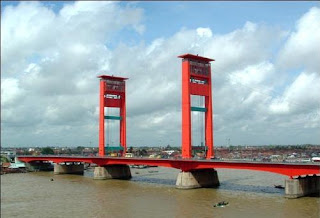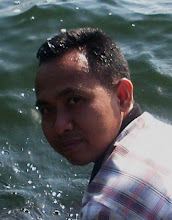South Sumatra
South Sumatra (Indonesian: Sumatera Selatan) is a province of Indonesia. It is on the island of Sumatra cover area 53,435.72 km2 (20,632 sq mi) with population 6,900,000 and borders the provinces of Lampung to the south, Bengkulu to the west, and Jambi to the north. Off the east coast are the islands of Bangka and Belitung, which were split from South Sumatra province to form the new province of Bangka-Belitung in 2000.
The capital of South Sumatra province is Palembang
This province is divided into 10 regencies:
- Banyuasin (Pangkalan Balai)
- Lahat (Lahat)
- Muara Enim Regency (Muara Enim)
- Musi Banyuasin (Sekayu)
- Musi Rawas (Muara Beliti Baru)
- Ogan Ilir (Indralaya)
- Ogan Komering Ilir (Kayuagung)
- Ogan Komering Ulu (Baturaja)
- East Ogan Komering Ulu (Martapura)
- South Ogan Komering Ulu (Muaradua)
Because of its sheer location on the southernmost rim of the South China Sea and close to one of world's busiest sea lanes linking the Far East with Europe, the region's historical background is undoubtedly rich and colorful. Once the very site of the Buddhist Kingdom of Sriwijaya, it practiced a bustling trade with then ancient China during its era of dynasties.
Inevitable of course, were the interacting forces of the two different cultures at the time which nowadays are still noticeable as consequences of the past.
Visitors can easily reach South Sumatera by air through four major airports at Palembang, Pangkal Pinang, Bangka and Belitung islands, all having direct connections with Medan, Batam, Padang, Jakarta, and not long from now with Singapore too. Air-conditioned buses from points North and West of Palembang are regularly available, as well as from cities on Java and Bali.
PLACES OF INTEREST
The Musi River
By Javanese standards the Musi river is both very broad as well as long, comparable to those found on the big island of Kalimantan, formerly Borneo. The river flows right through the city, cutting it in two halves called the Ulu bank and the Ilir bank and linked by a bridge of considerable size and length, called the Ampera Bridge. If visitors do not care to make an interesting or unique boat trip down the river, they could still take a walk halfway over the bridge to see the vast panorama surrounding them, rare at any other place in Indonesia. Down below they will see unbelievable traffic of boats, big and small, crisscrossing water lines without accidents as if steered by the most able navigators. From the same spot both halves of the city are clearly visible as well. And if the time is right, sunrises and sunsets as witnessed from the bridge would be an unforgettable sight of beauty. Worthwhile noticing are the floating restaurants and shops on both sides of the river, and other curious scenes of daily habits of the city's inhabitants.
An annual event is the Bidar Race, held on or around Independence Day, each 17th of August. Measurements of the competing boats are 24 1/2 m long and only 0.75 m wide, each boat carrying as many as 50 oarsmen.
"Limas", the traditional house
Another interesting item to see is the Limas house which are still found scattered over the province, most of them built on riversides, however, not facing the waterfront. One explanation could be that daily household activities can be done in full privacy, out of sight of passers-by.
These very ornate wooden houses built on stilts have rather sizable measurements: from 15 to 20 m in width and from 30 to 60 m in length. A good part of the house has hand-carved columns, door and window frames and cross ventilation between the rooms by placing wooden panels with flow-through carvings just below the ceilings. Indeed, it would almost be a must to observe the architecture and style of these Limas houses, some of them open to the public.
Ki Kede Ing Suro ancient cemetery
This cemetery dates back from the 16th century where as many as 38 ancient tombs are found of which one of them belongs to Ki Gede Ing Suro, one of the prominent forefathers of South Sumatera's present society. Notably, these 38 tombs are found under one roof of one building.
The State Museum
Relatively new the building was erected in 1977 only, however, its collection of around 2000 relics and antiquities originating from the province itself would make a visit here definitely worthwhile. See ancient household articles, utensils, looms, hunting tools, a bridal room and some preserved animals of the region.
Bangka Island's Matras Beach
Bangka can best be reached by air from Jakarta by scheduled flight in just about an hour by jet. However, boat service from Palembang to either Muntok or Pangkal Pinang is adequate and should not take more than an overnight voyage. This island lies right at the mouth of the Musi River in the South China Sea and is one of world's major producers of tin.
A beach of exceptional measurements, 300 - 400 m wide and 6 1/2 km long, called Matras Beach is located 44 km north of Pangkal Pinang, the island's capital. Fine, white and clean sands make this beach area most attractive to sun and beach lovers, whereas at this time the Parai Beach Hotel with 35 rooms already exists right on the beach.
On the other side of the island at Muntok you can find the Ranggam House built in 1921 on the hill overlooking the sea.
It is like a big lodging house where at one time the first Indonesian president was held captive along with some of his close followers during the nation's physical revolution.
The President's car at the time has still been kept in tact and can be seen by the public at the House's opening hours.
Closer to the capital is the Pasir Padi Beach, just 7 km from Pangkal Pinang and is merely a place to rest or swim and sunbathe.
There is no accommodation as tourists normally come to this beach from the city and villages around this place, 4 km long and about 20 to 60 m wide with endless coconut trees to give it a genuine tropical setting.
Belitung Island
Adjacent to Bangka island is Belitung island, another tin producer, with its capital city called Tanjung Pandan. If you are interested in visiting both islands, the best way to do it is to leave by air from Jakarta to either island first, and then cross over to the other one by boat and onward to Palembang to visit the rest of South Sumatera.
To save time, energy and money, it would not be recommended to make a special side trip to either Bangka or Belitung out of Palembang, but rather these three destinations should best be covered in a single line of direction.
The Belitung Tourism Development Corporation is at present in the midst of a huge tourism project at Tanjung Kelayang Beach, half an hour from the capital by car. A complete beach resort hotel with all modern facilities should be finished by 1992 and promises to become a great success for the area because of its proximity to Singapore, Sumatera and Java.
Punti KayuNatural Pine Forest
This recently built recreational complex covers an area of 50 hectares, consisting of four parts: an amusement park, a recreation park, an natural forest, and a man-made lake.
In this complex are to be found a children's playground, a cultural park, a souvenirs shop, restaurants and an information booth. Because of its proximity to the capital and easy accessibility, this complex actually caters mainly to the local inhabitants of the city of Palembang, however, international tourists may enjoy passing a calm day here to watch urbanites amuse themselves.
Tenang waterfall
Rich in the number of small as well as big rivers flowing through this province, waterfalls of various sizes come with them too. The biggest in the region is the Tenang waterfall where the water smashes down from a height of 90 meters into a deep pool and further downstream in a strong current. By public transportation it takes 2 hours from Palembang, however, less by private car. Located in the Muara Enim regency.
Kamero Island
Forty kilometers from Palembang, Kamero Island is a popular recreation site in the middle of the Musi river. the island has a Buddhist temple.
|





























